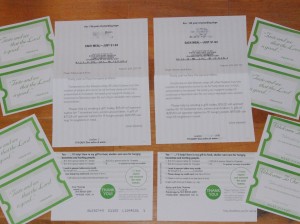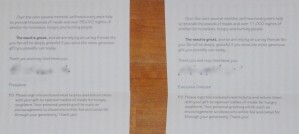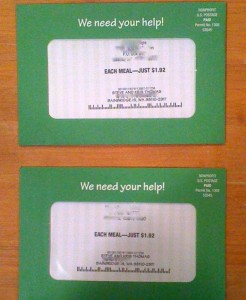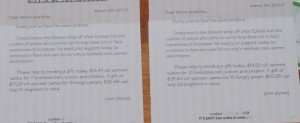This is a tricky post to write. I don’t want it to sound snarky or critical. I’ll trust you to let me know if I do fall off on the critical side of things (my intensity sometimes comes across a little too strong). Anyway, here goes.
Hoots came in from the mailbox a few days ago. She was laughing and holding a couple of green envelopes. She dropped them and the other mail on the table.
Two identical envelopes from two rescue missions in two different cities in the US.
Please understand, these are from two different organizations, thousands of miles apart.
I’ve disguised the organizations in question, because we love them. We’re donors to both of these rescue missions because we like their work. The missions are not near each other geographically and obviously use a syndicated direct mail program. That’s fine if that’s what they want. No gripe about them, in fact just the opposite, we love these ministries’ work.
Let’s open ’em up.
Here’s what the kits look like inside.
Pretty much identical. Not the greatest quality control, edges aren’t even and lines aren’t straight, but the messaging is readable. Not a logo in sight.
Hmmm… they did get our names right. Interestingly they have very much the same messaging. Nothing unique about either of these missions…apparently. But we know them both to be unique, special and very interesting. Also, we know a little about each of the leaders of these missions. And they’re interesting people. On the other hand, this isn’t very engaging is it?
Also notice the last paragraph. They’re using the same meal cost but doing a calculated ask based on giving history. Good for them to tailor our ask.
 The back of the letters, more of the same. Clearly one organization is bigger than the other, but that’s a technicality that won’t really motivate donors. There’s also a little of that pesky quality control showing but the letters are very consistent.
The back of the letters, more of the same. Clearly one organization is bigger than the other, but that’s a technicality that won’t really motivate donors. There’s also a little of that pesky quality control showing but the letters are very consistent.
So what’s my beef? Not with syndication if that is what you want to do. Not many donors will be like us and give to multiple nonprofits around the country…but there is a growing number who do.
My beef is that both of these organizations are unique, powerful, change agents in their respective communities. Both leaders, I believe, are charismatic, engaging and interesting. Sure wouldn’t know that from these pieces. The argument is usually: “No big deal, this is just a direct mail piece, we do very personal newsletters.”
Good. So you use very personal newsletters and very impersonal bland direct mail appeals? That’s good? Isn’t that confusing?
Then the argument becomes: “But it works.”
OK. Maybe it works….for now. And maybe you just think it works and don’t know how much better life would be if you were telling your story and letting some authenticity leak out…every where.
Then the argument becomes: “But it’s cheap.”
Really? It actually could be the most expensive mail you’ve ever produced if you’re persuading your donors that you are just like everyone else. If someone is printing and mailing thousands and thousands and thousands of pieces of mail every year for you that is doing nothing but painting you as pale, boring, lifeless…then it could be the most expensive mail you’ve ever mailed. (And that doesn’t even get into the whole flawed business model which is based on making money from how many pieces of mail are printed and mailed…but I’m trying not to get snarky, so…I’ll just breathe deeply).
I believe that donors are growing more and more sophisticated. Carpet bombing direct mail without regard for unique messaging, powerful branding and sophisticated data modeling is not a sustainable strategy. It just isn’t.
What happens if your bland direct mail letter lands in the mail box next to a vibrant, interesting piece chock full of authenticity and uniqueness? My guess is that you’re going to miss out on a gift.
I wonder how many times that is happening right now to your direct mail?
OK, that’s what I’m thinking. What about you? Agree or disagree? Let’s talk.
I always love hearing from you, even when you disagree with me.

Steve Thomas
Partner, Oneicity
photo credit: Bogdan Suditu



